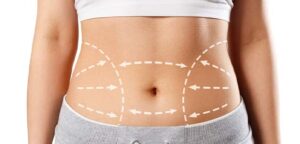All you need to know about tummy tuck
Abdominoplasty is a surgical procedure aimed at restoring the abdomen to its natural, flat, taut shape, and through it a set of steps are taken to remove excess sagging skin resulting from the loss of a large amount of fat, while working to tighten the muscles and return them to their normal shape, so the result is a belly A tight fit that satisfies the patient and encourages him to return to his life with confidence.
What is a tummy tuck? And what are its types?
Abdominoplasty is a suitable procedure for both men and women, and it is performed under general anesthesia including different degrees (100, 180, 270 and 360 degrees) depending on the patient’s condition. The difference between these types of operations lies in the amount of skin that must be removed. The more sagging the patient has in the skin, the larger the incision is required.

Mini tummy tuck
The procedure for this less complex procedure is similar to that of a classic tummy tuck. However, the lift is limited to a locally restricted abdominal area such as the lower abdomen. The skin incision required is usually shorter and the navel can remain in its normal position. In order to achieve an optimal result, it is necessary to wear a compression garment for 6 weeks, even with a mini-abdominoplasty

Full tummy tuck
A classic tummy tuck is a surgical procedure in which excess skin and fat pad can be removed. This requires a skin incision that runs horizontally over the pubic bone to the iliac crest. First, the abdominal skin is carefully separated from the underlying tissues up to the upper abdomen. In the next step, the diffuse abdominal muscles are adjusted and brought together in the middle, then the tissues separated from the abdominal wall are stretched and excess skin is removed by removing the sagging tissue.
When adopting this surgical method, you must wear a compression garment for 6 weeks in order to achieve optimal wound healing and a good outcome.

Who is suitable for mini and full abdominoplasty?
Abdominoplasty is suitable for people who have:
- Sagging, fat and cracks in the abdomen.
- Stretch marks during pregnancy and childbirth.
- Sagging skin as a result of significant weight loss.
- Mini abdominoplasty is performed for previous people who cannot perform a full abdominoplasty for health reasons.
The most important advantages of a surgical tummy tuck
The result is permanent as the excess tissue has been removed. However, if you gain weight, the fat will be stored again and the skin will stretch again. Normal fluctuations in weight (about 2-3 kg) are not impressive
What are the complications of a surgical tummy tuck?
Like any surgical procedure, some complications may occur after a surgical tummy tuck, including:
- Feeling of pain and fatigue.
- Allergic reaction to anesthesia
- Whipping infection
- Bleeding
- A blockage may occur in the blood vessels in the lungs as a result of the separation of the tiny fat cells and their movement in the bloodstream and blocking the blood vessels.
- Blood clots and potentially fatal cardiovascular complications, such as a heart attack or stroke, especially in people with pre-existing health conditions, such as diabetes, or cardiovascular, lung, or liver disease.
- Damage to the sensory nerves, and prolonged or permanent numbness, where the patient may feel a loss of feeling in the abdominal area, but it usually goes away with time.
- Accumulation of fluid under the wound.
- Temporary numbness in the thighs.
- The appearance of a scar along the lower part of the abdominal wall.

What are the most important preparations before a tummy tuck?
- Before having a tummy tuck, you must maintain a stable body weight for a long period of time. Under no circumstances should you starve yourself before the operation, as nutritional deficiencies can lead to wound healing disorders.
- Stop smoking for at least two weeks prior to the operation.
- Stop drinking alcohol for at least 48 hours before the operation.
- Stop taking medications that thin the blood, such as combinations of aspirin and ibuprofen.
- Avoid stimulants, such as coffee, for a week, because stimulants may affect the anesthesia process.
- Avoid blood-thinning drinks, such as green tea, which may cause heavy bleeding during and after the operation.
The period of stay in the hospital
Depending on the type of abdominoplasty, the patient may need to stay in the hospital for two to four days.
How long does it take to recover after a tummy tuck?
- You will have bandages to cover your lower abdomen, tubes to drain fluids that have accumulated under your skin, and these will usually be removed before you go home
- Wear a compression garment for up to six weeks after surgery
- The surgeon may prescribe pain relievers to the patient
- The patient should not drive, drink alcohol, or sign legal documents for 24 hours after general anesthesia
- It usually takes about six weeks to recover from the operation, depending on the type and method of abdominoplasty and the patient’s condition.
What should I do if complications occur after the operation?
You should see a doctor immediately when you notice a change in the color of the liquid draining from the filter tubes, or if you have a high body temperature, a feeling of shiver or coldness, or if you notice a bad smell from the wound, or exaggerated pain with excessive sweating.
How to choose the most suitable surgeon for a tummy tuck
Abdominoplasty is one of the common plastic surgeries, but despite this, the surgeon’s experience plays an important role in obtaining the best possible results while minimizing the risks after surgery, as Zen Clinic Hospital in Turkey is characterized by the presence of the best plastic surgeons in the field of obesity surgery, which guarantees the patient better results with fewer postoperative complications.
The most Important tips from Zein Clinic after a tummy tuck
- Taking care of the wound, and following up with the doctor to change it and keep it clean
- Moisturizing the wound site and avoiding any factors that could cause any infections, such as tight clothes or made of coarse fabrics
- Taking care of proper nutrition and eating foods that contain vitamins such as vitamin A and zinc
- Take care not to stop the movement within simple limits and without exerting excessive effort to maintain the weight and also to prevent the formation of clots, as we mentioned above.
- The patient should take a leave of absence from work about four weeks after the surgery.
- Avoid movements that cause stress to the abdominal muscles.
- No exercise or strenuous effort for at least six weeks.
This content has been approved by Zein Clinic doctors
To contact the doctor and provide a free consultation, click here:
Did you like our theme? You can share it with your friends now!
Read more:
Possible pain and swelling after liposuction
Body sculpting and its most important techniques
Sources: Clevelandclinic


 واتساب
واتساب